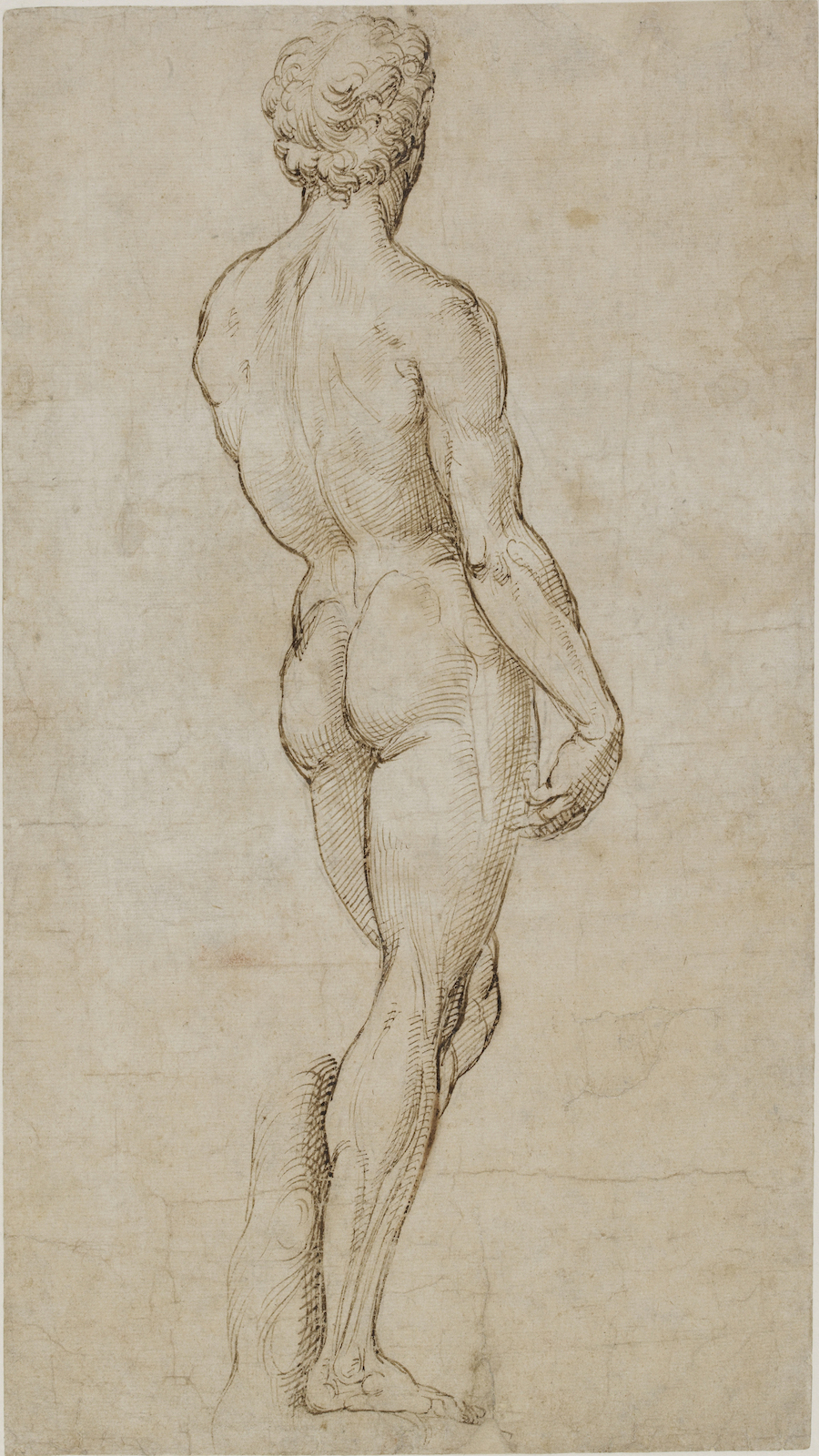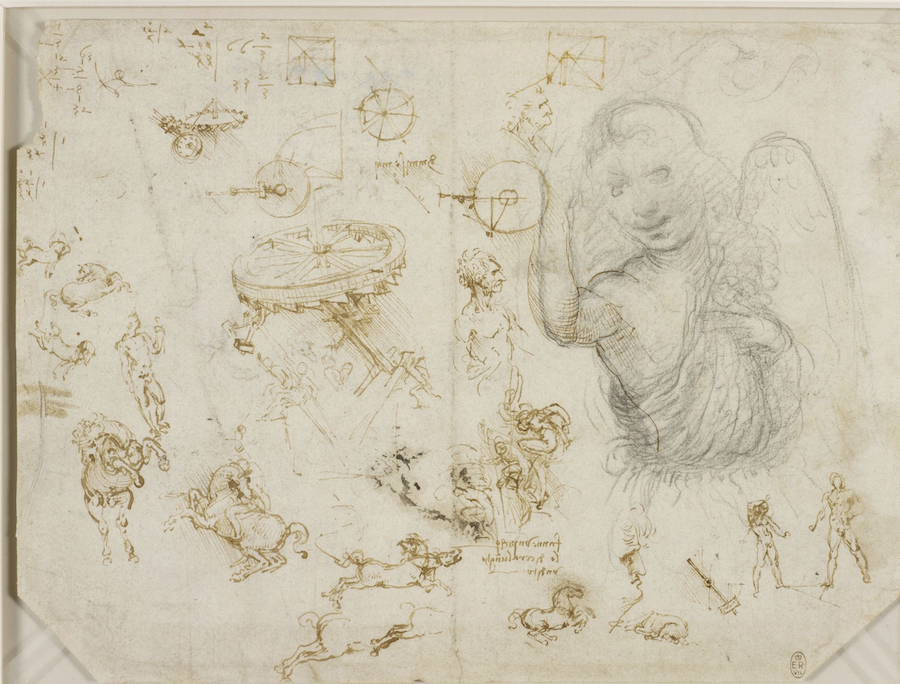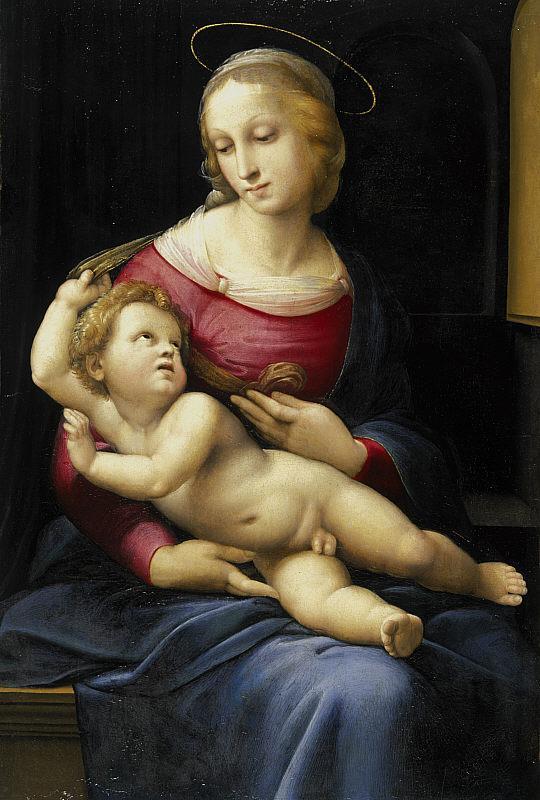
Black chalk and pen and brown ink with white chalk on paper,
Remember when Messi, Ronaldo and Mbappé for only that one magic season lined-up for Fiorentina? Unfortunately that line-up never happened, it’s pure fantasy football. But in terms of reputation(while perhaps not so much in talent) those three football players come close to the superstar artists that Florence managed to attract back in 1504.
That was the year that Michelangelo, Leonardo and Raphael lived and worked, at times in close proximity to each other, in Florence. Michelangelo and Leonardo were already established artists and there was a fierce rivalry brewing between them. Raphael was yet to make a name for himself in a major city. Leonardo (52) was 23 years older than Michelangelo and 31 years Raphael’s senior.
The Royal Academy of Arts (RA) has put together a fascinating exhibition focusing on these three artists and the short time they shared the same stage in Florence. It was inevitable that artists of this caliber would feel a rivalry, while at the same time pick up ideas from each other. The Royal Academy has gathered almost 50 drawings, cartoons, paintings and sculptures to give us an idea of the competitive spirit and the artistic battles that turned Florence during the early 16th century into one of the cultural capitals of Europe.
Leonardo and Michelangelo grew up in Florence and were apprenticed to prominent artists in the city. The local talent pool of painters, sculptors and architects was truly unequaled, but Lorenzo de’Medici, despite having a reputation as a great patron of the arts, couldn’t afford large commissions. Many artists, including Leonardo and Michelangelo, started looking for more lucrative opportunities, even before the Medicis were expelled in 1494 . The Duke of Milan, Ludovico Sforza, became Leonardo’s patron and among the works he commissioned was The Last Supper (1495-1498) and a large equestrian monument to his father Francesco Sforza which was never finished. Before a bronze casting could be made of the large clay model the statue was destroyed by the French forces that conquered Milan.The bronze was repurposed for the production of cannons.
The turbulence following Lorenzo de’ Medici’s death and the Dominican friar Savonarola’s consequent power grab made Michelangelo flee Florence. In Bologna he was hired to supply two figures of saints and an angel for a shrine in the Basilica of San Domenico. He carved a big, erotically strapping, nude Bacchus holding a cup of wine for a Cardinal in Rome. More prestigious (and less scandalous) was the commission he received for the Pietà, which originally was destined to form part of a French Cardinal’s funeral monument (now in the St. Peter Basilica). The moving representation of the grieving, serenely beautiful Madonna, cradling her son in her lap, received much acclaim and established Michelangelo’s reputation. In 1501, when the work dried up in Rome, he was asked to sculpt fifteen saints for an altar in the Siena cathedral, of which only four were finished. Michelangelo was already in danger of getting a reputation for accepting assignments he wouldn’t finish when a better offer came along.

But when the Overseers (Operai) of the Florence cathedral in 1501 asked Michelangelo to create a monument of the Biblical giant-slayer David, he committed himself wholeheartedly to the much sought–after project, which already had been botched by a couple of artists. Leonardo was also considered for the job, but this time he was eclipsed by his biggest rival. It took Michelangelo more than two years to finish the nearly 17 feet tall marble sculpture. It was deemed too good (as well as too heavy) to adorn one of the flying buttresses, high up on the Florence Duomo. The young shepherd armed with his sling and posing in classical contrapposto pose was a symbol: he was seen as Florence’s Herculean defender of the republic’s freedom. (Another theory is that it is a self-portrait, as Michelangelo seems to have implied in a drawing.) A roll call of the city’s most talented 30 painters, architects and sculptors were tasked with deciding where the giant nude should be placed. Among the decision makers were Botticelli, Perugino, Filippino Lippi, Piero di Cosimo and of course Leonardo da Vinci. Leonardo haughtily opined that David should be hidden away in a courtyard. He proceeded to sketch a less heroistic figure with a more harmonious body and a smaller head. Magnanimously he also gave Michelangelo some notes on how to improve the sculpture! But Michelangelo won the day and got his way. His statue, weighing 8.5 ton, was rolled out from the workshop of the Opera del Duomo and took four days to reach its very central spot on the Piazza della Signoria, outside the Signoria Palace.
Crowds gathered outside to admire (and some miscreants to throw stones at) the statue, while inside the Palazzo della Signoria (today known as Palazzo della Vecchio) Leonardo was working on an enormous mural depicting the Battle of Anghiari in the newly built Sala del Gran Consiglio. But just like Michelangelo, Leonardo was not one for completing projects. Nearly a year had gone by since he received the commission for the fresco, but Leonardo had been distracted by studying the flight of birds, inventing flying mechanisms and solving mathematical problems. He had also started work on a portrait of a certain Lisa Gherardini (that is Mona Lisa to you and me). But how did Leonardo react when his rival Michelangelo was invited to work side by side with him? Only a few months after his triumph with David Michelangelo was asked to produce a mural glorifying another famous Florentine victory, The Battle of Cascina. The battle scene was to be painted on the very same wall, just next to, where Leonardo’s painting was supposed to take shape ! The Republican government clearly wanted the two artists to go head to head, to compete, and for all to judge who would come out on top!

Neither of the murals were ever finished. Both cartoons (a full-sized drawing that is used to transfer the subject to a canvas or a wall) hung next to each other in the large hall for nearly a decade. We know that Michelangelo, while working on the Cascina battle, was also carving the stunning Bruges Madonna sculpture, which was shipped to Bruges in 1506. But both artists appeared to be busy with their battle frescoes as well. Paper was ordered for the pair of them and paid for in 1505. Leonardo put up some scaffolding, but surviving letters tell us that both artists were admonished for not finishing in time the work that they had been paid for. In April 1506 Michelangelo was invited to construct a papal tomb for the reigning Pope Julius II in Rome and a month later Leonardo was summoned back to Milan. That was the end of that rivalry (there were more to follow) and the murals never made it onto the wall. There is some evidence that Leonardo actually did start painting but abandoned the work when the paint wouldn’t stick to the wall (where, oh where, had he encountered the same problem?). Both he cartoons were much admired, but they were eventually taken down when the hall was renovated and enlarged in the second half of the 16th century. Giorgio Vasari was tasked with painting new frescoes.
The Royal Academy has assembled some preparatory drawings for both murals. Of particular interest is Bastiano da Sangallo’s copy of The Battle of Cascina, despite it only showing the central part of the composition.
Julien Domercq is a co-curator of the exhibition. Listen to his explanation of what we see in The Battle of Cascina.

If you want to hear more about what happened to the cartoons and why the mural that Leonardo started working on didn’t survive, listen here to co-curator Julien Domercq.
The general public took the opportunity to admire the works while they were in situ. We have a fair idea idea of what was lost, because so many artists copied the cartoons. Raphael was one of the artists who, according to Vasari, came to Florence to see Michelangelo and Leonardo in action.
Raffaello Santi or Sanzio came from Urbino, a three day horse ride from Florence. His father was a court painter ¨of no great merit¨ according to Vasari, but his son turned out to be an exceptionally precocious talent. Raphael was an apprentice of the Umbrian master Pietro Perugino, but soon outperformed him in every sense. Raphael was working in Siena when he heard that both Michelangelo and Leonardo were decorating the council hall in Florence. He knew he had to take this opportunity to study their work, to see them in action. In October 1504 he arrived in Florence and he stayed until 1508. There is a study in the exhibition that seems to be inspired by Michelangelo’s Battle cartoon. Julien Domercq explains the significance of the drawing Two male nudes seen from behind.
By observing Leonardo, who was his age’s best student of nature, Raphael learnt how to use the sfumato technique (smoky, soft shading instead of clearly lined shapes) and he also started emulating Leonardo’s pyramidical compostion technique. Raphael’study of Leonardo’s painting Leda and the Swan is shown in the exhibition, but the older master’s influence is even more evident in a number of portraits of young ladies that Raphael painted during his stay in Florence. He clearly copies Mona Lisa’s three-quarter pose, with the subject mostly turned towards the viewer, and even has his models resting their right hand on the left (a traditional symbol of modesty), so that the resemblance with Leonardo’s masterpiece is striking. Unfortunately none of these portraits or studies are featured in this exhibition.

But the show can provide evidence of how a Michelangelo sculpture made a mark on some of Raphael’s much loved Madonna-and-child paintings. The Royal Academy is in an unique position to do this, because they are the custodians of the Taddei Tondo, also known as The Virgin and Child with the Infant St. John.
The Virgin in Michelangelo’s marble sculpture appears to give all her attention to St John the Baptist holding a bird (probably a goldfinch). She takes no notice of her son who recoils from the bird, knowing that it foretells his destiny (death and resurrection).
Raphael makes some drawings of his peer’s dynamic tondo, but he works out his own design and the elegant result can be seen in the Bridgewater Madonna painting on loan from the National Galleries of Scotland. Raphael adapts the outstretched and contorted shape of the young Christ in his mother’s lap from Michelangelo’s sculpture. But he reverses the Child’s position and makes him look up at his mother expectantly, while she glances down at him and is physically more involved than the marble Madonna. She almost seems to say: ¨it’ll be fine, in the end …. no worries¨.

Raphael did manage to secure a number of reasonably prestigious commmssions from Florentine patrons, thanks to introductions made by Leonardo. But no major jobs ensued from his stay. Rapheal only really cemented his reputation for graceful perfection when he was invited in 1508 by Pope Julius II – the very same Pope that had instructed Michelangelo to come up with a grand design for his tomb – to fresco the Pope’s private library at the Vatican Palace. Among the competitors for this job were, yes, none other than Leonardo and Michelangelo. When Raphael had finished painting the library, he was commissioned to do the rest of the ‘Stanze’, where the Pope received his visitors. When that major task was finished most observers seemed to agree that ‘ his works were more strictly in accordance with the rules of art than Michelangelo’s¨ and that he was ¨fully equal, if not superior, to Leonardo in painting generally…. ¨, according to Vasari.
Well, Michelangelo didn’t take it well and he accused Raphael of plagiarism. It’s true that he had been able (in secret) to watch while Michelangelo’s masterpiece went up on ceiling of of the Sistine Chapel. Raphael was undeniably inspired by Michelangelo but only to the extent that it drove him on to create something even more brilliant than he originally set out to do. He could never be accused of copying Michelangelo. But instead of feeling flattered by the younger artist’s ‘tribute’, Michelangelo gave vent to his bad temper and jealousy. After Raphael’s death (in 1520) Michelangelo wrote that ¨everything he knew about art, he got from me¨.
The Royal Academy has mounted a glorious exhibition that will almost certainly make you want to see more and travel to all those Italian cities where the major works of Leonardo, Michelangelo and Raphael are on show.
The Italian Renaissance is in vogue at the moment with the BBC presenting a new three part series, with Charles Dance in the role of Michelangelo. A short walk from Burlington House (the Royal Academy) through Green Park will take you to the King’s Gallery (part of Buckingham Palace) where the Royal Collection is showing 160 drawings by 80 Italian Renaissance artists , including works by Michelangelo, Leonardo and Raphael!
Read my review of that exhibition here: https://acge.net/culture/renaissance-drawings-from-the-royal-collection/
MICHELANGELO LEONARDO RAPHAEL Florence, c. 1504 is at the Royal Academy of Arts until 16 February 2025
https://www.royalacademy.org.uk/exhibition/michelangelo-leonardo-raphael


